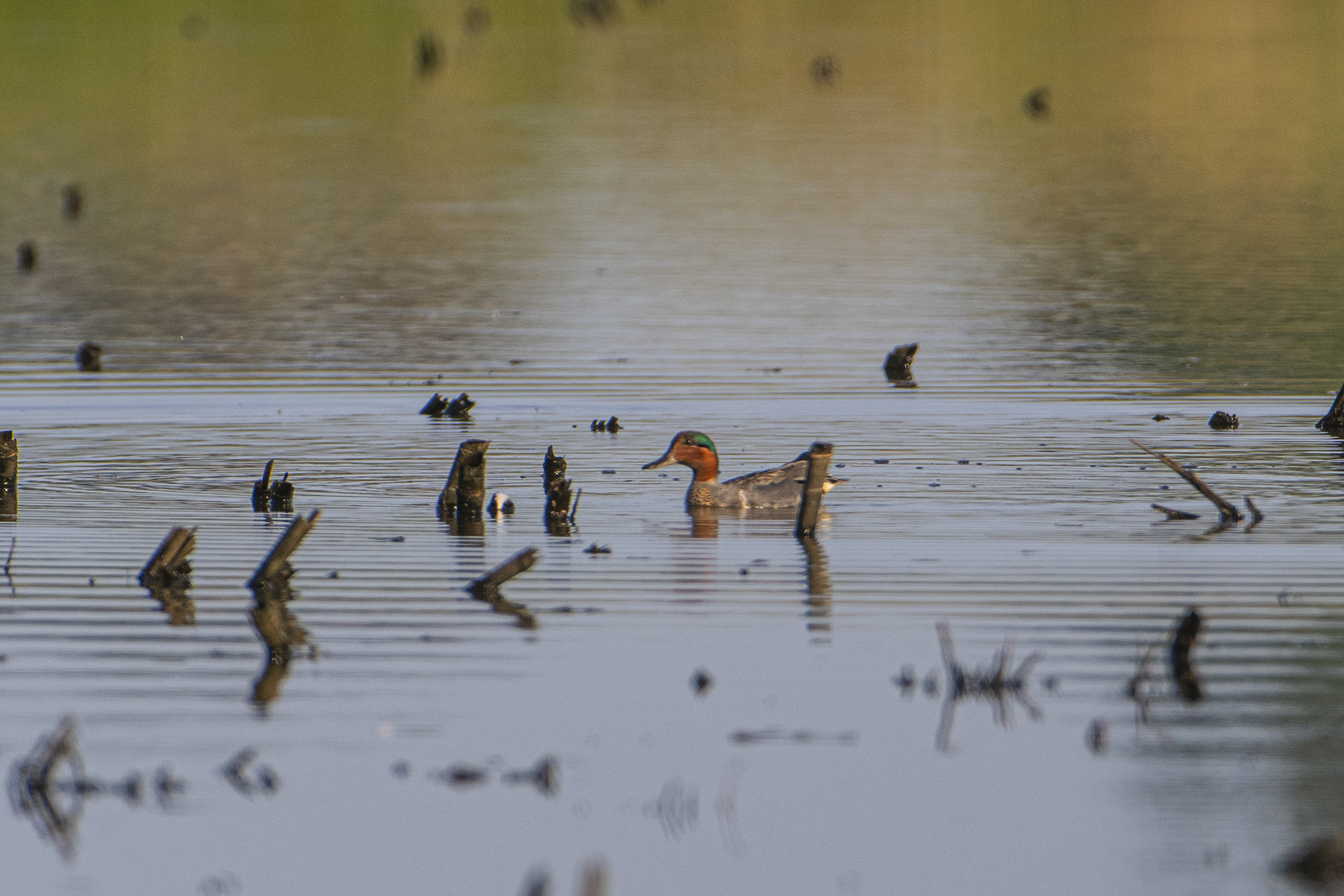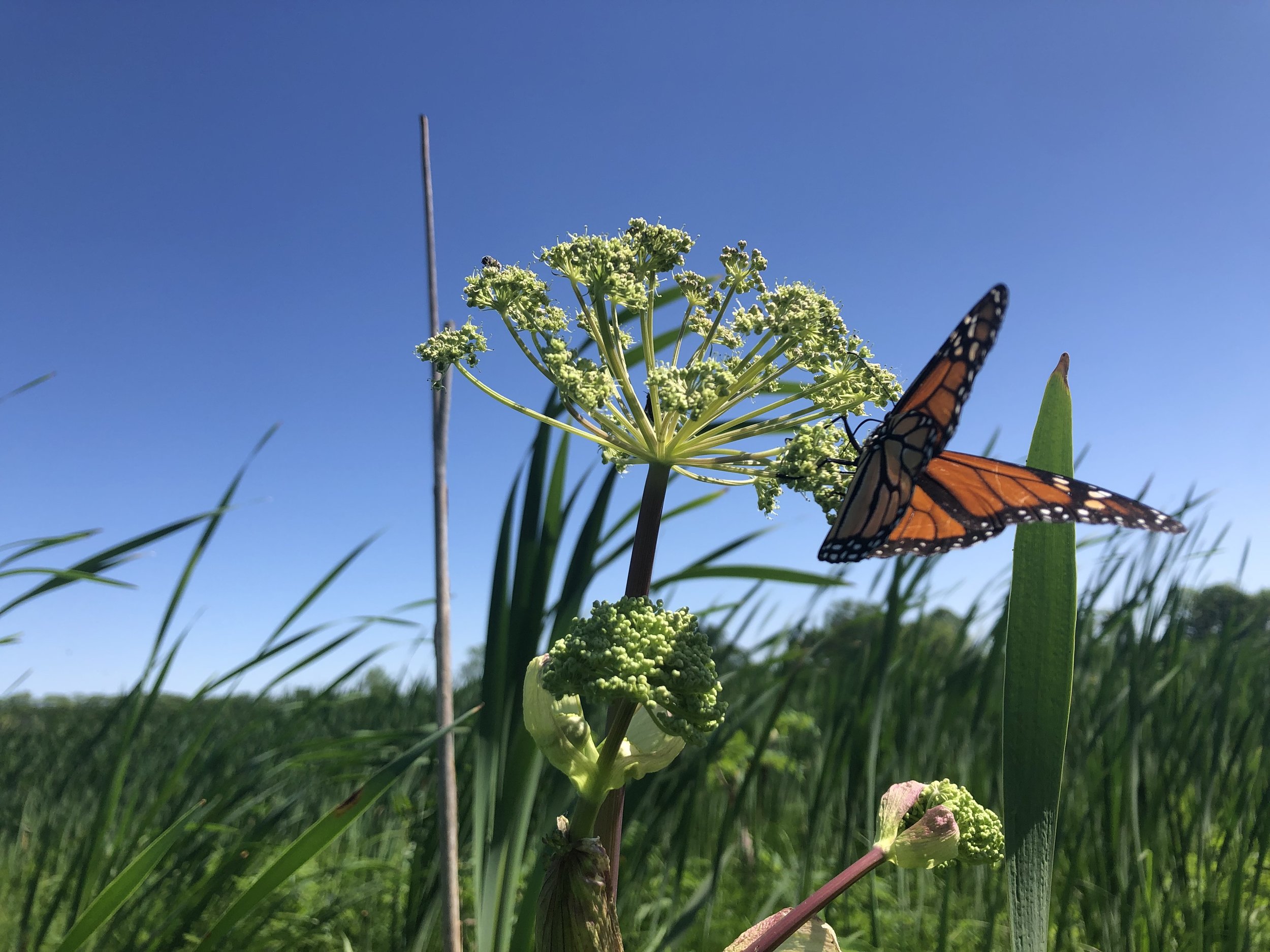North America’s smallest waterfowl carries a descriptive, charming name. Male green-winged teal sport a chestnut brown head with an iridescent green streak that appears to run through their eyes, have gray bodies, and sport a beige patch near the tail. A vertical white stripe on their sides is a prominent field identification mark. Females are mottled brown in color, and both sexes have an iridescent green wing speculum, for which they are named. The green-winged teal is a common migrant and uncommon summer resident at Goose Pond Sanctuary. In November 2008, we counted a record high count of 550 individuals at Goose Pond. We frequently find green wings feeding in shallow water for seeds and aquatic invertebrates along with northern shovelers.
Female (left) and male (right) green-winged teal. Photo by USFWS
According to the Cornell Lab of Ornithology, “Green-winged Teal are numerous and their population has increased over recent decades, according to waterfowl surveys conducted by the U.S. Fish and Wildlife Service. They estimated the North American breeding population in 2015 was at least 4 million, almost double the long-term average… Most of the population breeds in Canada and Alaska, where relatively remote and inaccessible nesting areas buffer this species from habitat losses farther south caused by agricultural and urban development.”
Green-winged teal range map, courtesy of Cornell Lab of Ornithology’s allaboutbirds.org
Volunteers have been busy surveying birds for the Breeding Bird Atlas II that is ending this summer. One of our goals this year at Goose Pond was to confirm green-winged teal, the smallest waterfowl species in North America. Brand Smith recently confirmed nesting trumpeter swans, the largest waterfowl species in North America, about three miles away at Schoeneburg Marsh/Erstad Prairie.
One of the four photos taken in the past five years of a breeding female green-winged teal in Wisconsin. Photo by Richard Armstrong
Comments from our June 20th Breeding Bird Atlas report:
“We have small numbers of green-wings nesting at Goose Pond every year. Usually we do not see the broods due to the emergent arrowhead. The water is too high for arrowheads at this time and broods are easier to see. Mark was walking along a wetland edge south of the Kampen Road residence when a female green-winged flushed and did a detraction display. The green on the speculum was visible without field glasses from 25 feet. Could see at least six young… Mark went back for the field glasses and this time saw the female and a male about 20 yards from the female. This spring we had two pairs and two males but have not seen any green wings since about mid-May. What a pleasant surprise.”
Later that evening we searched for more waterfowl broods and were pleased to find six broods of blue-winged teal along with broods of mallards, northern shovelers, and hooded mergansers. The Cornell Lab of Ornithology states that “The male green-winged teal defends its mate from copulation attempts by other males, then deserts the female once incubation is underway. A few hours after they hatch, the chicks can swim, dive, walk, and forage for themselves, although the female continues to brood them at night and to protect them when the weather turns cold.” It is interesting that we saw the male nearby even after the eggs hatched. We have also noticed one male blue-winged teal interacting with a brood and female.
A green-winged teal male hangs out at Goose Pond, near the female and brood, an unusual behavior for this species. Photo by Richard Armstrong
Ours is the first green wing confirmation in Columbia County and the nineteenth confirmation state-wide. In Breeding Bird Atlas I (1995-2000), Brand confirmed the only brood of green wings in Columbia County at Grassy Lake State Wildlife Area, and greens wings were confirmed in 35 blocks. Most bird books show that green wings only migrate through Wisconsin on their range maps. We assume that the Wisconsin Breeding Bird Atlas II data will be used in the future to update summer range maps.
We hope you visit Goose Pond Sanctuary this summer to see ducklings and other wetland bird broods. Abundant water has receded little due to above normal rainfall including 5.7 inches of rain in the past week, and wildlife viewing opportunities are excellent.
Thanks to Richard Armstrong for taking photos to document the green-winged teal.
Written by Mark Martin and Susan Foote-Martin, Goose Pond Sanctuary resident co-managers
Cover photo by USFWS



















